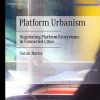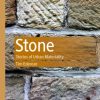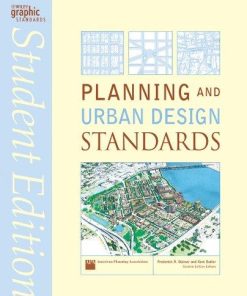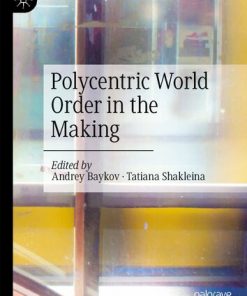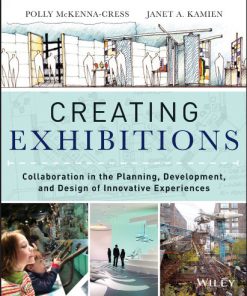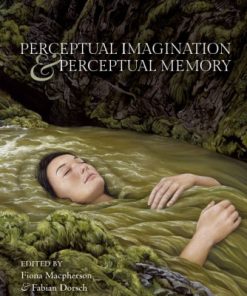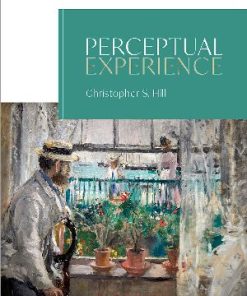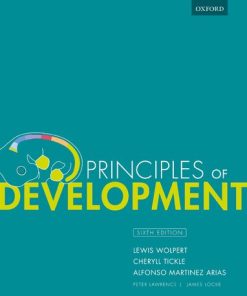Design and Order Perceptual Experience of Built Form Principles in the Planning and Making of Place 1st Edition by Nigel Lewis 1119539552 9781119539551
$50.00 Original price was: $50.00.$25.00Current price is: $25.00.
Design and Order : Perceptual Experience of Built Form – Principles in the Planning and Making of Place 1st Edition by Nigel C. Lewis – Ebook PDF Instant Download/DeliveryISBN: 1119539552, 9781119539551
Full download Design and Order : Perceptual Experience of Built Form – Principles in the Planning and Making of Place 1st Edition after payment.

Product details:
ISBN-10 : 1119539552
ISBN-13 : 9781119539551
Author : Nigel C. Lewis
This book offers an integrated understanding of both the principles and the perception of the design of built environments and public spaces. It outlines the fundamental characteristics that are evident in the creation of built form and illustrates how they determine the experience of resultant places. It also consolidates the key criteria that need to be taken into consideration in the development of these areas. All of the above-mentioned aims to provide designers with a solid understanding of the implications of their decisions on perception and behavior during the creation of new spaces.
Design and Order: Perceptual experience of built form – Principles in the Planning and Making of Place starts by examining the designing of natural environments and the affect that they have on humans. It teaches readers how people experience and are shaped by a space–via their eyes, brain, and overall perception. It then instructs on proper grammar of form and syntax so that designers can understand how to pursue design processes systematically. The book then takes readers through this process of designing, informing them on the principles of form, function, configuration, communication, organization, color and contrasts, building structures, good practice and more.
Design and Order : Perceptual Experience of Built Form – Principles in the Planning and Making of Place 1st Table of contents:
Section I: The Environment
Part I: The Environment – Natural, Ecological and Historical (Topography)
1 Natural Sites and Places
1.1 Nature and Landscape
1.2 Natural Places and Characteristics
1.3 Creation of Man‐Made Places
1.4 Existential Space and Place
1.5 Natural Landscape and Sensing
Further Reading
2 Ecological and Climatic Context and Basic Protection Needs
2.1 Primitive Needs
2.2 Climatic Zones and Natural Materials for Shelter
2.3 Shelter Types, Uses and Purposes
2.4 Socio‐Cultural Factors and Human Needs
2.5 Theory of Human Needs
Further Reading
Note
3 Historical and Regional Development
3.1 Historic Eras and Development
3.2 Regional Variations, Early Cultures and Settlements
3.3 Topography, Climate and Materials – Form Determinants
Further Reading
Section II: Human Behaviour and Design
Part II: Human Behaviour (Neuro‐Physiology)
4 The Brain, the Mind and Sensing
4.1 The Brain and Neurological Systems – Seeing, Touching and Hearing
4.2 Seeing – Visual Processing and Memory
4.3 Touching and Hearing
4.4 The Mind – Mental Learning and Thinking – Cognition
4.5 The Mind – Visceral Feelings – Emotion and Motivation
4.6 Consciousness and Self
4.7 Human Body and the Sensing of Form
4.8 Meaning, Intentionality and Imagination
4.9 Metaphor and Consciousness
Further Reading
5 The Eyes and the Visual System
5.1 Visual Perception
5.2 Visual World and Visual Field
5.3 Visual Perception and Affordances
5.4 Perceptual Experience – Visual System
5.5 Visual System and Optic Arrays
5.6 Recognition, Eye Movements and Analogue Theory
Further Reading
Note
6 The Senses
6.1 The System of Senses
6.2 The Senses
6.3 Further Senses
6.4 The Senses and Multi‐Sensory Experience
6.5 Multi‐Sensory Emotions, Feelings and Aspirations
6.6 Pleasure
Further Reading
Note
Part III: Perceptual Experience of Form (Psychology and Phenomenology)
7 Aesthetic Theories and Perception of Built Form
7.1 Perception
7.2 Theories of Perception
7.3 Schematisation and Phenomena
7.4 Equilibrium, Wholes and Re‐centring
7.5 Parts and the ‘Whole’
7.6 Perceptual Properties
7.7 Perception of Form
7.8 Psychology of Form
7.9 Dynamics of Space
7.10 Perception and Cognition
7.11 Meaning and Symbols
7.12 Synopsis – Perceptual Experience
Further Reading
Notes
Part IV: Grammar and Syntax of Form, and Composition
8 Architectural Ordering, Composition, Form and Beauty
8.1 Order
8.2 Grammar of Design and Syntax
8.3 Composition and Characteristics
8.4 Rhythm and Harmony
8.5 Purposiveness
8.6 Objects and Arrangements
8.7 Composition and Type
8.8 Ways of Ordering
8.9 Objective Properties
Further Reading
Note
Part V: Planning and Design Process, and Programme Requirements (Methodology)
9 Design Framework, Methods and Approaches
9.1 Problem Formulation
9.2 Setting
9.3 Fitness and Fit
9.4 Self‐Conscious Design Approach
9.5 Affordances and Behaviour Settings
9.6 Programme Requirements
9.7 Designing and Design Approaches
9.8 Design Process, Reflection and Appraisal
9.9 Intended Results and Evaluation
9.10 Design of ‘Good’ Form
Further Reading
10 ‘Pattern Language’ Approach
10.1 Form Language
10.2 Order and Life – ‘Wholeness’
10.3 Life‐Creating Transformations of Centres
10.4 Language of Form
10.5 Fundamental Maxim – ‘Unity’ of the ‘Whole’
Further Reading
Notes
Section III: Form, Function and Fit
Part VI: Form and Fit
11 Physical Built Form in Space
11.1 Form – Mass and Spatial Volume
11.2 Transformation of Form
11.3 Additive Form
11.4 Integration of Forms
11.5 Form and Space
11.6 Horizontal Planes
11.7 Vertical Planes
11.8 Architectural Space, Enclosures and Vistas
11.9 Spatial Qualities and Layout
11.10 Light, Sound and Atmospheric Qualities in Built Form
Further Reading
12 Geometrical Layout and Organisation – Axes, Shapes and Repeating Patterns
12.1 Datum and Axes
12.2 Ordering Principles
12.3 Hierarchy and Scale
12.4 Rhythm and Repetition
12.5 Symmetry
12.6 Transformations
12.7 Generative Design Processes
12.8 Fractals
12.9 Other Forms of Geometry – Non‐Euclidean
12.10 Patterns of Repeating Elements for Decoration
Further Reading
13 Proportion, Symmetry and Harmony
13.1 Proportion – History
13.2 Proportion and Physical Relationships
13.3 Symmetry
13.4 Human Proportions
13.5 Room Proportions
13.6 Regulating Lines
13.7 Latent Geometric Relationships
13.8 Good Proportioning
13.9 Anthropometrics and Human Factors
13.10 Scale
13.11 Harmony
13.12 Expressions of Form
Further Reading
Photos
Notes
14 Organisational Forms and Layout
14.1 Linear Organisation
14.2 Centralised Organisation
14.3 Radial Organisation
14.4 Grid
14.5 Clustered Organisation
14.6 Interior Enclosed Space
Further Reading
Note
15 Functional Purpose and Use of Space
15.1 Function
15.2 Utility, Significance and Purposefulness
15.3 Use, Activities and Spatial Requirements
15.4 Structural System and Components
15.5 Materials
15.6 Personal Space
15.7 Territoriality
15.8 Defensible Space
Further Reading
16 Circulation, Plan and Elevation
16.1 Approach
16.2 Entrance
16.3 Dynamic Spatial Experience
16.4 Configuration for Communication
16.5 Access Paths
16.6 Internal Circulation
16.7 Stairs and Staircases
16.8 Built Section
Further Reading
17 Colour and Contrast
17.1 Light and Spectrum
17.2 Colour Pigments
17.3 Pigments for Printing
17.4 Complementary Colours
17.5 Features of Colour
17.6 Colour Circle, Sphere and Star
17.7 Perceptual Basis of Colour
17.8 Colour Interaction
17.9 Colour Serialisation
Further Reading
Part VII: Building Structure and Types
18 Structure
18.1 Beginnings
18.2 Laws of Nature
18.3 Lateral Stability
18.4 Materials
18.5 Design Methods
18.6 Connections and Jointing
18.7 Structural Types
18.8 Maintainability and Sustainability
18.9 Generative Parametrics
18.10 Resiliency
Further Reading
Photos
Section IV: Built and Urban Form
Part VIII: ‘Good’ Practice – Built Form
19 Buildings and Dwellings
19.1 Space and Human Interaction
19.2 Creation of ‘Place’
19.3 ‘Good’ Building
19.4 Built Form Determinants
19.5 Re‐Use
19.6 Use Types of Buildings
19.7 Goals of ‘Good’ Built Form
Further Reading
Photos
Part IX: ‘Good’ Practice – Urban Form
20 Urban Form
20.1 Form Determinants in Urban Settlements – Natural and Man‐Made Features
20.2 Historical Developments
20.3 Different Regional and Cultural Typologies
20.4 Multi‐Nucleus and Mixed Development
20.5 Modern Developments
20.6 Elements of Urban Form
20.7 Legibility
20.8 Organisation
20.9 Life Space and Topology
20.10 Urban Form and Life
20.11 Layout of Urban Neighbourhoods
20.12 Development
20.13 ‘Good’ City Form
20.14 Urban ‘Open’ Forms
20.15 Goals of ‘Good’ Urban Form
Further Reading
Photos
Summary
Development of Built Form and Human Needs
Planning and Design Process
Composition and Ordering Principles in the Making of Place
Note
Bibliography
Appendices – Part I
Appendix I.3.1: Ancient Settings – Europe, Near East, Asia and Americas
I.3.1.1 Neolithic Age 10 000–3000 BC – Mid East and Europe
I.3.1.2 Bronze Age 3000–1000 BC – Europe and Mid East
I.3.1.3 Ancient Iron Age 1000 BC to 0 AD – Mid East
I.3.1.4 Early Age 0–1000 AD – Europe and Mid East
I.3.1.5 Mesoamerica to 1500 AD
I.3.1.6 North America to 1500 AD
I.3.1.7 Asia and the Orient to 1500 AD
I.3.1.8 Africa to 1500 AD
I.3.1.9 Europe – Mediaeval Cities After 1000 AD
Further Reading
Photos
Appendix I.3.2: Ancient City Places
Further Reading
Appendices – Part II
Appendix II.6.1: Feelings of Space and Form in the Environment
II.6.1.1 Natural Light
II.6.1.2 Movement
II.6.1.3 Complementarity of Form
II.6.1.4 Balance
II.6.1.5 Individuality
II.6.1.6 Opaque Geometry and Occlusion
II.6.1.7 Sense of Spatial Perception
II.6.1.8 Form Sensing
Further Reading
Note
Appendix II.6.2: Artificial Perception
Further Reading
Appendices – Part IV
Appendix IV.8.1: ‘The Classical Orders’
IV.8.1.1 The Orders
IV.8.1.2 Tuscan
IV.8.1.3 Doric
IV.8.1.4 Ionic
IV.8.1.5 Corinthian
IV.8.1.6 Composite
IV.8.1.7 Entasis
IV.8.1.8 Composition
IV.8.1.9 Language – Elements of Architecture
Further Reading
Photos
Notes
Appendix IV.8.2: Aesthetic Judgement and Beauty
IV.8.2.1 Utility and Delight
IV.8.2.2 Qualities
IV.8.2.3 Beauty
IV.8.2.4 Assessment of Beauty
IV.8.2.5 Interest and State of ‘Disinterestedness’
IV.8.2.6 Form and Elegance
IV.8.2.7 Aesthetic Theories and Self‐Conscious Design
IV.8.2.8 Sense of Beauty as Described in Different Eras
Further Reading
Note
Appendices – Part V
Appendix V.9.1: Design Methods – Comparative Historical Design Approaches and Pedagogy
V.9.1.1 Classical Design
V.9.1.2 Renaissance Design
V.9.1.3 European Design Methods
V.9.1.4 Modern International Design Methods
V.9.1.5 Purist Design
V.9.1.6 Rational Geometric Design
V.9.1.7 Organicist Design
V.9.1.8 Modern Design Methods and Systems Approach
V.9.1.10 Generative Computerised Design
Further Reading
Appendix V.10.1: Pattern Language – Design and Human Needs (Illustration)
Further Reading
Appendices – Part VI
Appendix VI.13.1: Decoration – Patterns, Features, Motifs and Geometrics of Repeating Elements
VI.13.1.1 Decoration – Materials, Methods and Techniques
VI.13.1.2 Features
VI.13.1.3 Pattern Groups – Floral, Figurative, Geometric and Representational
VI.13.1.4 Pattern Arrangements – Lattices, Powdering, Borders and Features
VI.13.1.5 Emergent Forms
VI.13.1.6 Special Motifs and Symbols
Further Reading
Appendix VI.13.2: Ornament in Earlier Times and Historic Era
VI.13.2.1 Antiquity
VI.13.2.2 Mediaeval
VI.13.2.3 The Renaissance
VI.13.2.4 Recent
VI.13.2.5 ‘General principles in the arrangement of form and colour in architecture and the decorative arts’, – The Grammar of Ornament – (Owen Jones 1856)
VI.13.2.6 Moresque Principles of Ornament – Owen Jones
Further Reading
Appendices – Part VIII
Appendix VIII.19.1: Building Materials and House Types in Vernacular Britain
VIII.19.1.1 Walling
VIII.19.1.2 Roofing
VIII.19.1.3 Types – Plan and Section
Further Reading
Photos
Appendix VIII.19.2: Building Elements and Features
VIII.19.2.1 Floors, Walls and Ceilings
VIII.19.2.2 Windows and Doors
VIII.19.2.3 Mouldings
VIII.19.2.4 Assembly
Further Reading
Photos
Note
Appendix VIII.19.3: Architectural Styles, Periods and Practitioners
VIII.19.3.1 Western Architecture
VIII.19.3.2 Religious Periods
VIII.19.3.3 Composition Methods – Theorists and Key Practitioners by Era
Appendix VIII.19.4: Historic Ecclesiastic and Civic Buildings; Geometric Modern and Iconic Modern US Buildings
VIII.19.4.1 Historic Ecclesiastical Buildings
VIII.19.4.2 Historic Civic Buildings
Appendices – Part IX
Appendix IX.20.1: Urban Places
IX.20.1.1 Urban City Form – Historic Places
IX.20.1.2 Modern 20th Century Places
Appendix IX.20.2: Sustaining Principles
IX.20.2.1 ‘Ten Theses on Architecture’ – Rob Krier
IX.20.2.2 ‘Ten Principles on Which We Can Build’ – HRH The Prince of Wales
IX.20.2.3 ‘The Hannover Principles’ – Expo 2000 World Fair, William McDonough
IX.20.2.4 ‘One Planet – Living Communities Programme’
IX.20.2.5 Biophilic Design Principles
Further Reading
Appendix IX.20.3: Urban Settlement Models and Patterns
IX.20.3.1 Urban Form and Use Types
IX.20.3.2 Urban Layout Principles
IX.20.3.3 Organising Features
IX.20.3.4 Building Form Types
People also search for Design and Order : Perceptual Experience of Built Form – Principles in the Planning and Making of Place 1st:
design perceptions
design and perform an experiment
describe the components of form perception
define perceptual organization
an example of a perceptual set
Tags: Design, Order, Perceptual Experience, Principles, the Planning, Making of Place, Nigel Lewis
You may also like…
Uncategorized
Politics & Philosophy
Policy Design in the European Union: An Empire of Shopkeepers in the Making? 1st Edition
Politics & Philosophy - International Relations
Uncategorized
Politics & Philosophy
Uncategorized
Biology and other natural sciences - Biology
History & Research
Jung, Dante, and the Making of the Red Book: Of Fire and Form 1st Edition


